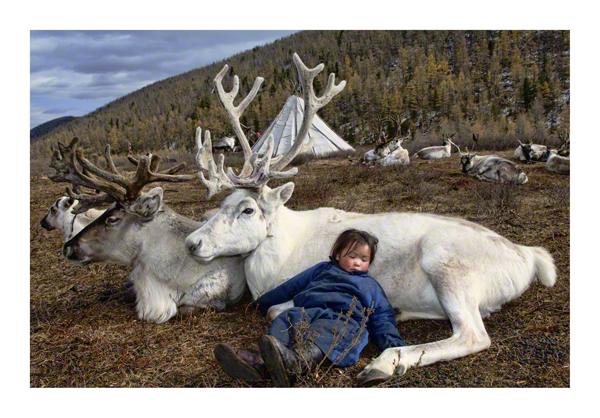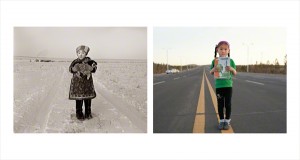Duhalar child falls asleep on a white reindeer as her mother milks the herd nearby. Sornuk Valley, Hovsgol Province, Outer Mongolia. Photo by Hamid Sardar-Afjhami
Loving photography as I do, it’s always a treat to see what’s new at The Annenberg Space for Photography, and the latest show did not let me down: no strangers: ancient wisdom in a modern world explores the essential question of our existence: what does it mean to be alive? The answers come in the form of fetching images and extraordinary stories from photographers who have immersed themselves in the lives of indigenous people around the globe. The show opens on Saturday (11/17) and will be in town through the end of February 2013.
My family always enjoys a visit to the small, high-tech space of the gallery itself but beyond just the fun of the outing, there are many reasons this show should be on your holiday list! From a visual point of view, there are multiple entry points for kids’ interest (starting with a plethora of photos of children and animals) and, best of all, the subject matter provides rich topic for conversation — from the science behind the Human Genome Project, to how having a camera changes the dynamic of a relationship with the subject, and how globalization affects indigenous people around the world.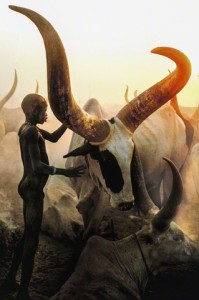
A Dinka boy from South Sudan lavishes endless care and affection on his animals which he considers part of the family. He is named after his favored ox, his Namesake Ox, in the hope he will mature with the same strength and beauty.
Curated by noted anthropologist Wade Davis, no strangers is a whirlwind tour of the unique corners of our planet, and introduces us to many cultures that are in danger of vanishing in our increasingly homogenized world. Davis notes that “diversity is our greatest strength as a species” and the 140 photographs in the galleries tell a compelling story of the breadth of this diversity. Families will enjoy reading the stories behind the photographs — in an age of when a picture tells a thousand words, it’s interesting that many of these images portray something so unusual to our eyes that we must slow down and read the caption.
For instance, the Pakistani hunting technique portrayed in this image is 5000 years old, and that heron on the hunter’s head is actually alive.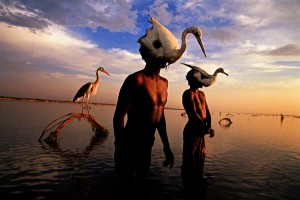
Photo by Randy Olson
The show’s accompanying documentary film — which you must see! — follows photographers around as they do their work, and expands upon the show’s themes. As Wade Davis explains in the film, the Human Genome Project has been able to trace the DNA of every race of people on the earth back to a single human strain. The film then asks — if science can prove that we are all connected through our DNA, how are we protecting the specificity of our brothers and sisters around the world? As globalization threatens these indigenous cultures and as technology connects us all in way that encourages homogenization, are we losing site of our uniqueness? What is the price of progress when half the languages in the world are not being taught to the children in that culture?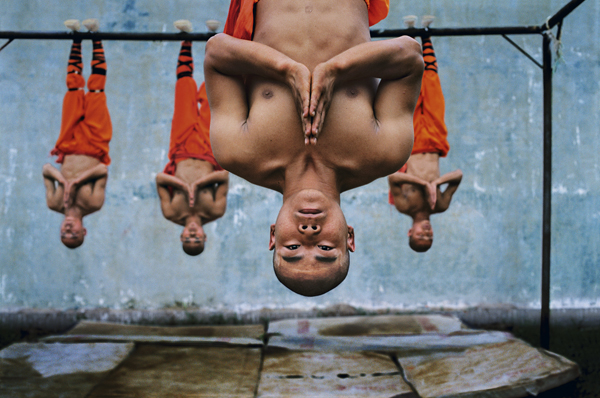
Photo by Steve McCurry
Each image carries a story of how a particular race of people have survived and flourished through time. I was particularly taken with the work of two women photographers from London, Carol Beckwith and Angela Fisher, who have spent 35 years cataloging the rituals of African tribes, producing over 15 books on the topic, and their attention to the beautiful detail of ritual scarification and rites of passage is incredible; it turns out that having a tattoo is part of more cultures than not. I was also touched by a series of images by A Yin who photographed a child in his or her indigenous home in black and white and then, returning several years later, photographed that same child – in vibrant color tones – learning to adapt to city life. It’s a clever portrait of the speed of change across the globe.

